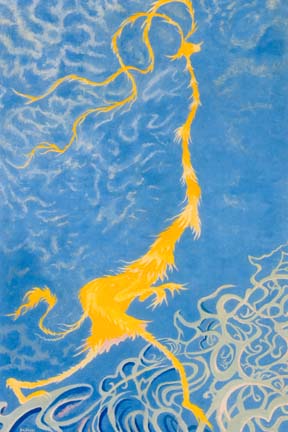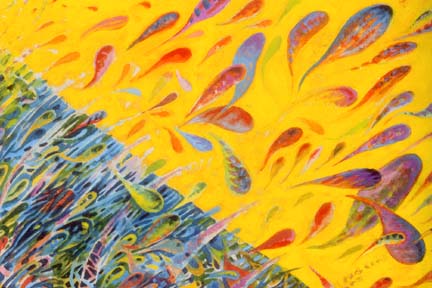
[ MAUKA MAKAI ]
An exhibition delves into
the works of the famed author
THE NEXT TIME your youngster won't try that new veggie, rather than pontificating, open up "Green Eggs and Ham." "You do not like them, so you say. Try them! Try them and you may," will probably be more effective persuasion than, "If I've told you once, I've told you a thousand times, vegetables are good for you."
Dr. Seuss -- Theodor Seuss Geisel in real life and author of the classic story -- had a way with words and illustrations that approached such touchy subjects as supper-time strife with warm humor and gentle guidance.
In his 53 years as a children's author, Geisel likely made his biggest mark by revolutionizing children's literature with "The Cat in the Hat" (published in 1957). The story of a feisty cat who wreaks havoc on a home was intended as a primer, a response by book publishers Houghton Mifflin and Random House to the issue of "why Johnny can't read."
Theodor Geisel's "Blue-Green Abelard" from 1934, at left, is part of a collection of sculptures he named the "Unorthodox Taxidermy." One theory was that the "Dick and Jane"-type primers of the time were staid and antiseptic. Enter Geisel, hired to write a book using 220 first-grade level vocabulary words. Turning the children's literary world on its ear, he mixed storytelling, poetry, rhythm and rhyme together with fanciful illustrations to create works that have appealed to generations of readers. By the time of his death in 1991 at age 87, Geisel had written 44 books and won a Pulitzer Prize for his contributions to children's literature.
But for all his accomplishments in the literary realm, that field was just one facet of Geisel's professional accomplishments. He was also a political cartoonist, ad man, sculptor and Academy Award and Emmy winner. Beginning Tuesday, a national exhibition celebrating Geisel's 100th birthday will display a lifetime of his work at the Dolphin Galleries in Honolulu, Maui and the Big Island.
Hawaii will be the second stop of "The Art of Dr. Seuss -- A Retrospective Exhibition," which will tour the United States throughout 2004. The exhibit will be showing in museums and art galleries in cities such as San Francisco, New York City, Chicago and Denver. "'The Art of Dr. Seuss' will expand people's understanding of Theodor Geisel," says Christian Adams, of Dolphin Galleries. "They will see his humor, his satirical wit -- his genius, really."
"Cat from the Wrong Side of the Tracks," a 1964 work that reflects Geisel's sense of humor: notice the nude feline on the pool-playing tomcat's tie.
GEISEL WAS BORN on March 2, 1904, in Springfield, Mass., to Theodor and Henrietta Geisel. The elder Theodor was a brewmaster. Henrietta had worked in her father's bakery before she married. There, she would memorize the pies that were on special each day and would "chant" them to her customers.
In later years, when her son would have trouble sleeping, Henrietta would recite her pie chants, and after he was grown, the author credited his mother "for the rhythms in which I write and the urgency with which I do it."
Geisel studied at Dartmouth and then Oxford, and decided to earn his living as an artist with the encouragement of Helen Palmer, who would become an accomplished author in her own right and his first wife. In 1927, Geisel began his career as an editorial cartoonist for such publications as Life, Liberty, Judge, Redbook, Vanity Fair and the Saturday Evening Post.
"He pretty much worked for the top magazines of the day in the 1920s and '30s," says William Dreyer, curator of "The Art of Dr. Seuss."
Geisel's unique humor then attracted ad executives, and in 1935 he landed a Standard Oil account. This began his 20-year advertising career for companies like Ford Motors and NBC. The ads from some of those accounts will be on display in the exhibit.
"It's a wonderful thing to see all the stuff (Geisel) did years before he became Dr. Seuss the book author," Dreyer says. "Whether he did an ad for a bug spray or a children's book, the works were (signature) Geisel."
By World War II, Geisel had published several children's books, including "And to Think That I Saw It on Mulberry Street" and "Horton Hatches the Egg." But when the war started, Geisel decided to put his writing and drawing aside and serve in the armed forces. During the war years, Geisel worked on military training videos and documentaries, which won him Academy awards in 1946 and 1947.
"Cat Carnival in West Venice," a watercolor and pencil on board, is an intricate, moody work. Cats were a favorite subject of Geisel's, perhaps because his first wife, Helen Palmer Geisel, owned 14 pet cats. IN 1958, a year after "Cat in the Hat" and "How the Grinch Stole Christmas!" were published, Geisel became president of Beginner Books, a young reader's division of Random House Children's Books.
Publisher Bennett Cerf, whom Geisel and first wife Helen helped to found Beginner Books, became a close friend, and Cerf wagered that Geisel couldn't write a book using 50 words or less. Geisel took on the challenge, and in 1960 published "Green Eggs and Ham," which joined other Dr. Seuss titles such as "The Cat in the Hat Comes Back," "Yertle the Turtle and Other Stories" and "One Fish Two Fish Red Fish Blue Fish." "The Sneeches" was published in 1961, followed by "Hop on Pop" in 1963, "Fox in Socks" in 1965, "Mr. Brown Can Moo!" in 1970 and "The Lorax" in 1971, among other works.
"Oh, the Places You'll Go!" was published in 1990, just a year before Geisel's death. At the time of his death, some 200 million copies of Geisel's books, translated into 15 different languages, had found their way into homes across the globe.
Through all those years, Geisel remained steadfastly committed to children's literacy. His support of the cause continues today through the efforts of his second wife, Audrey, who heads Dr. Seuss Enterprises.
An ad Geisel created for an insecticide called Flit. Geisel had a 20-year career as an ad man before finding fame as a children's book author and illustrator.
Seuss experts Adams and Dreyer believe the enduring success of Dr. Seuss's books comes from Geisel's attitude in writing for youths.
"He revolutionized the idea of what writing for children could be, because he didn't write down to children," Adams says. "He respected them and challenged their intellect."
Dreyer agrees. "Geisel said he didn't write for children, he wrote for people. He has fun with children in his works, and they in turn perceive Dr. Seuss as one of their own. The Cat in the Hat comes over and wrecks the house and then puts it back together again -- Geisel gets rowdy with children."
The beauty of Geisel is that, amid all the fun rhymes and engaging drawings, he packs in a message, as well.
"In 'The Butter Battle Book,' he talks about the nuclear arms race. In 'Horton Hears a Who,' he writes that 'a person is a person, no matter how small,'" Dreyer says. "Yet he didn't pound people over the head with his messages. With Geisel, there was a simplicity of translating ideas. And he did it in a respectful way."
He adds: "At the end of 'The Cat in the Hat,' the boy is wondering if he should tell his mother about the Cat. The last words of the book are: 'What would you do if your mother asked you?' He lets the children make the decision. He shows respect for their values."
The "Golden Girl" creature is reminiscent in style of many of Geisel's children book illustrations.
THE EXHIBIT will bring to the public for the first time works from Geisel's private collection, including paintings from his estate and sculptures he called "Unorthodox Taxidermy." His works reflect various artistic styles, making evident that Geisel was influenced by a number of different periods of art.
Limited editions of the works will be available for purchase, many with an affordable price tag. Prices range from $200 to several thousand dollars. The accessibility to the pieces pleases Adams immensely.
"These museum-quality works are being offered with the concept that the collection could be bought for families to enjoy," he says. "And this being only the second stop on the tour, the selection will be fabulous.
"In collecting artwork, the most beautiful homes have art that reflect the people living in it. It may be from places they have traveled or things from their childhood. Dr. Seuss's artwork appeals to people who have found his books safe and comforting, and who want to share this with the next generation."
"The Art of Dr. Seuss:
Where: Dolphin Galleries
A Retrospective Exhibition"When: 9 a.m. to 10 p.m. daily beginning Tuesday through the end of the month at the Hilton Hawaiian Village gallery on Oahu, Lahaina gallery at 697 Front St. on Maui, and Waikoloa gallery at the King's Shops on the Big Island
Receptions: 5 to 9 p.m. Tuesday in Honolulu, Dec. 26 in Lahaina and Jan. 2 in Waikoloa. Features appearances by the Cat in the Hat.
Call: 949-9900 at the Hilton, toll-free at 808-669-5051 from neighbor isles and mainland, and 893-1000 on Maui.
Click for online
calendars and events.








